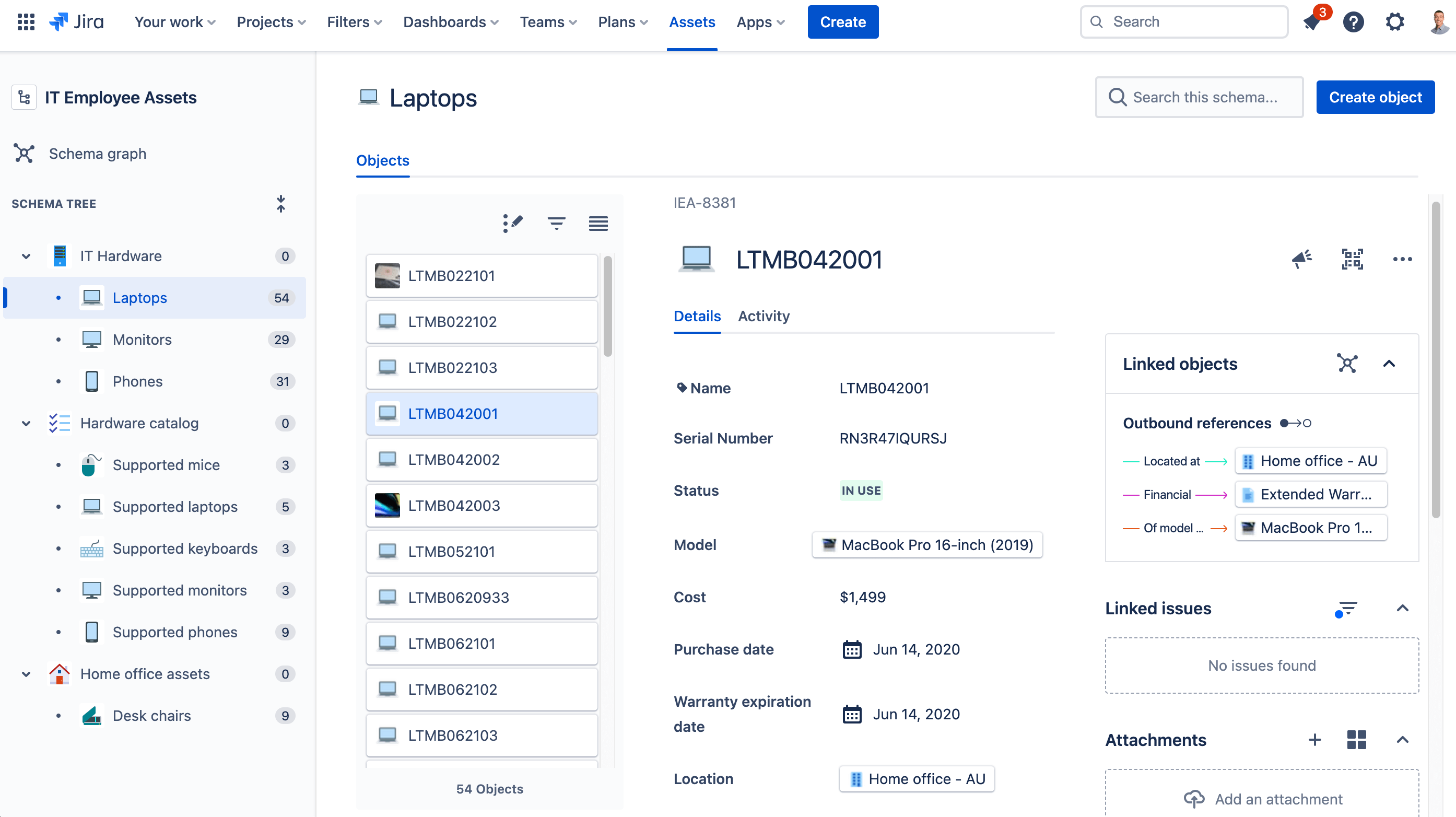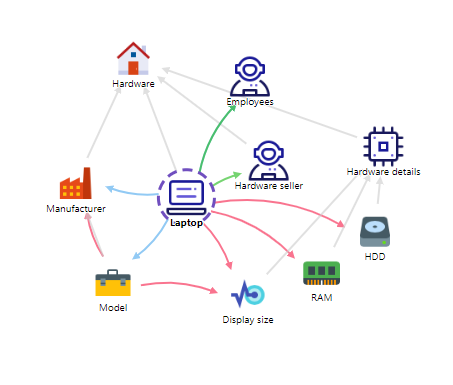Three options to optimize your company's processes and attain its business objectives using a configuration management database
A configuration management database (CMDB) can serve various purposes. The following article summarizes several use case examples that illustrate the effectiveness of a CMDB in implementing a company's processes and business goals.
The examples are based on the CMDB built into the Atlassian Assets application.
What is configuration management?
Configuration management can be defined in many ways. In the context of a CMDB, it is about defining and documenting the functional and physical characteristics of configuration elements.
By nature, it is also part of change management, which includes configuration changes to IT systems during the system's life cycle, such as implementing new software or conducting upgrades.
1 - managing configuration items in CMDB
A configuration item (CI) is an entity within a configuration that satisfies an end-use function and that can be uniquely identified at a given reference point. The CMDB gathers the organization's essential configuration items, the details and the relationships between them.
Items can be both tangible and intangible. For example, CMDB can contain physical or virtual servers, network devices, software applications and licenses, as well as personnel or buildings.
Configuration items are grouped into schema(s) and structured typically in descending order, such as:
- Denominator of objects - IT hardware;
- Object type - computers;
- Object - a specific laptop.

Figure 1. An example of the Assets scheme, showing the structure of the scheme (IT Employee Assets) and a detailed view of one laptop with its attributes and references to other objects (Linked objects).
Detailed information related to the object is described in the object's attributes. Attributes are like custom fields in different types and they can be created in the application. A computer's attributes can be things like user, serial number, status (used, free) or location.
Why establish a CMDB when an Excel spreadsheet might suffice?
Initially, Excel can do the job, but static table lists may soon become insufficient as the company grows and the volume of managed configuration elements increases.
CMDB, however, not only structures and documents elements but also facilitates the creation of dynamic relationships between objects.
References are created at the object level through an attribute to which another object in the CMDB can be selected.
As an illustration, consider the onboarding process for a new employee. This involves:
- Providing details about the employee, such as their personal identification number, date of birth, probationary period, and type of employment contract.
- Supplying necessary tools, like a laptop.
From the CMDB point of view, two objects are engaged in the process - the user (described in the personnel schema) and the laptop (documented in the asset schema).
Upon selecting the computer, the employee is assigned to the "User" attribute of the computer, establishing the connection between the device and the employee. The referencing feature also creates a connection within the user's (object) perspective.
This eliminates the need for manually duplicating relationships in a static table list. Furthermore, relationships between different object types can be visually represented on a graph.

Figure 2. The graph displays detailed information about the computer and its connection to the user. Note: The given structure is not a fixed solution and may need customization for each organization.
The CMDB structure varies among organizations and is crafted according to the managed configuration elements and their relationships.
Identifying relationships through AQL queries
Assets has its query language AQL (Assets query language), just like Jira has JQL (Jira query language).
What makes AQL particularly powerful is the ability to inherit objects according to their relationships with other objects. For example, you can search for all applications associated with a service.
Furthermore, you can create queries to include more than two objects - for example, it is possible to find all assets related to some application which is associated with a service.
Automations
In Assets, it is possible to create customized automations that help keep the database up-to-date, monitor the life cycle of assets or plan replacements.
For instance, a computer possesses a "Status" attribute offering options like "In Use" and "Free". When a user is linked to the computer, the automation shifts its status to "In Use"; conversely, removing the user changes the status to "Free."
Furthermore, automation can enhance HR department efficiency. For example an automation rule that sends email reminders about an employee's approaching end of the probationary period or an upcoming birthday.
2 - supporting IT service management (ITSM) practices
In essence, IT service management or ITSM is simply how IT teams manage the end-to-end delivery of IT services to customers. Among other, this includes all the practices to plan, deliver, operate, and support IT services.
IT services can cater to both internal and external users. Effective service management relies on a combination of well-documented, informed, and interconnected objects. However, these alone may not fully support the management of IT service management practices.
Assets is integral to Atlassian's Jira Service Management (JSM), designed to collaboratively support various ITSM practices. Below, we delve into some of these practices in more detail.
Incident management
An incident is an interruption in the planning of services or a significant reduction in the quality of services. With JSM customer portal, customers can report the incident by filling in the required fields, which values can be inherited from Assets.
This process enables users to promptly link the incident to a specific service or application. Subsequently, the support team can depend on the CMDB as the primary source of truth to pinpoint affected configuration items and grasp their impact zones.This overview enables the prompt resolution of critical incidents.
Problem management
Problem management is the process of identifying and correcting the root cause(s) of an incident. Tickets registered in Jira Service Management generate a historical overview of incidents.
In this way, teams can analyze patterns, identify causes and implement solutions, reducing the number and impact of incidents.
Change management
Change management is a set of activities for directing and documenting changes to the organization, its IT systems, processes, etc.
While the CMDB helps analyze the potential impact of a change on configuration elements, the execution of the change can be controlled using a JSM ticket and a Jira workflow. Planned and well-managed changes reduce the number of incidents and enable rapid detection when they occur.
3 - Applying security policies and standards
In an era of increasing cyber threats, securing IT infrastructure is critical to businesses.
A CMDB can be successfully used to document security configurations and monitor compliance with security policies to strengthen security posture, mitigate risk, and ensure a proactive approach to cybersecurity.
How to choose a CMDB application?
There are many applications on the market for managing a CMDB. When making a choice, it is worth considering some aspects, like:
- How are IT service management practices currently managed?
- Is the CMDB tool compatible with the application where IT service management practices are managed?
- Can you create multiple schemas to manage different asset categories?
- What are the options to configure permissions? Is it possible to grant permissions per schema and per object type? Are viewing and editing permissions differentiated?
- Does the tool support automation?
- Can you import data and integrate with external tools?
For Assets, its primary value stems from the following aspects:
- It's part of Jira Service Management - if your company already uses Jira Service Management, there is no need to purchase a separate application;
- Flexible scheme creation - Assets stands out by enabling the creation of an unlimited number of schemes to manage various asset categories.
- Detailed permission logic - within the scheme, viewing, changing, and administrative rights can be precisely regulated based on object type.
- AQL queries - it employs a specific query language to establish relationships between objects.
- Automations - Assets features custom automations that streamline database maintenance and reduce manual workload.
- Import and integration options - Assets supports importing from CSV and JSON files, and it seamlessly integrates with external systems like AWS, Microsoft Entra ID (formerly Azure AD), and Google Cloud.
Achieving business goals with a CMDB
Businesses across diverse industries can gain significant advantages from implementing a configuration management database.
A well-executed CMDB serves as a foundational element for numerous processes and practices, contributing to the achievement of business goals.
For insights and practical recommendations on implementing a configuration management database, consider exploring the case study detailing the University of Tartu's experience in CMDB implementation.







